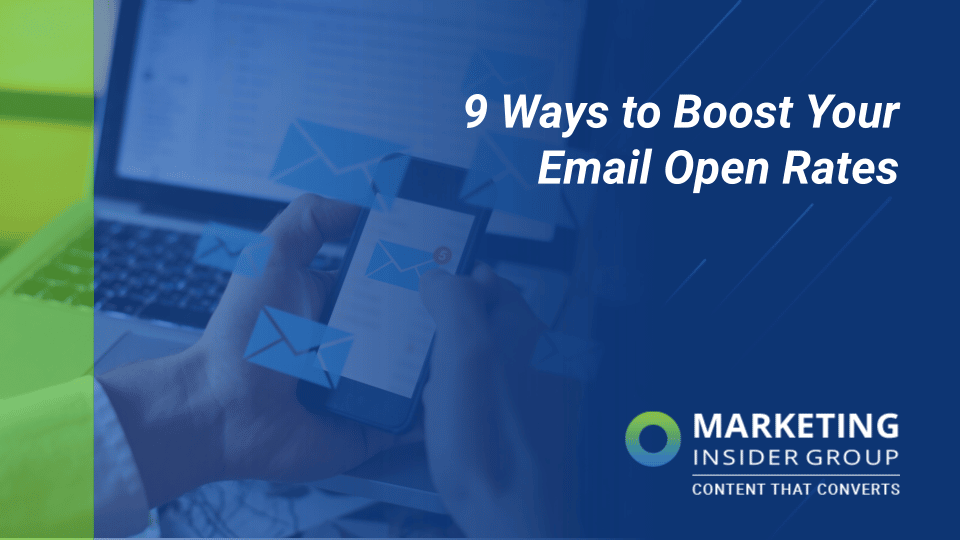
15 Ways to Boost Your Email Open Rates
We’ve all got crowded inboxes — the average professional receives 120+ emails every day. Still, email far and away remains the most preferred method of brand communication for consumers across generations and industries. For this reason, your email open rate is a critical piece of your overall marketing ROI.
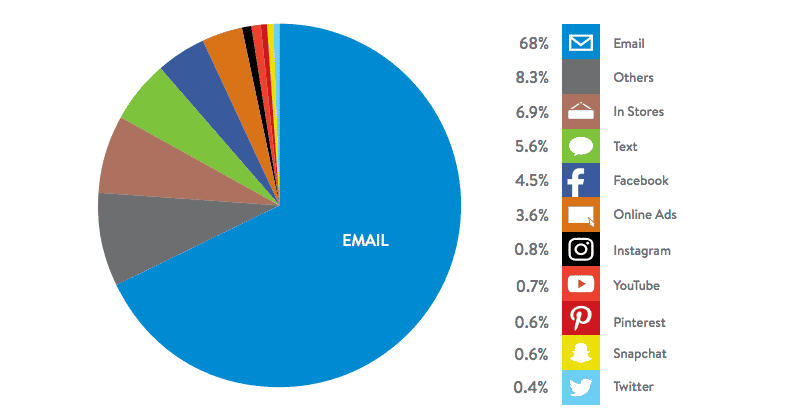
Image Source: Bluecore
When you’re executing an email marketing campaign (or managing email every day for your company) it can be easy to get laser-focused on content. After all, that’s what matters most, right?
Absolutely.
But your email content can’t perform if no one’s reading it. And no one’s reading it without first opening the emails you send.
So how do you make sure your email recipients are opening your messages to read the great content inside? That’s what we’ll cover in this article. In the sections that follow, we will:
- Go over the basics about email open rates
- Explain how to find and/or calculate your open rates
- Walk through X actionable ways to increase open rates
Let’s get started!
Quick Takeaways:
- Email open rate is calculated using the number of successfully delivered emails.
- The average email open rate is about 20% across industries.
- More than one-third of people decide whether or not to open an email based on the subject line alone.
- It’s critical to follow CAN-SPAM guidelines to avoid the spam filter.
- You can use tactics like segmentation, personalization, and A/B testing to refine your strategies for better email open rates.
What Is Email Open Rate and Why Does It Matter?
Your email open rate is the percentage of delivered emails being opened by your recipients. Delivered is a key word here — emails that bounce or are undeliverable for another reason will not be included in open rate calculations.
Open rate is one of the most commonly used metrics by email marketers to evaluate the success of their campaigns. Open rates are important because they indicate whether or not your brand name and subject lines are catching your audience’s attention in their inboxes.
How to Calculate Your Email Open Rate
Calculating your email open rate is fairly straightforward. Take your total emails opened and divide it by the number of emails sent minus those that bounced.
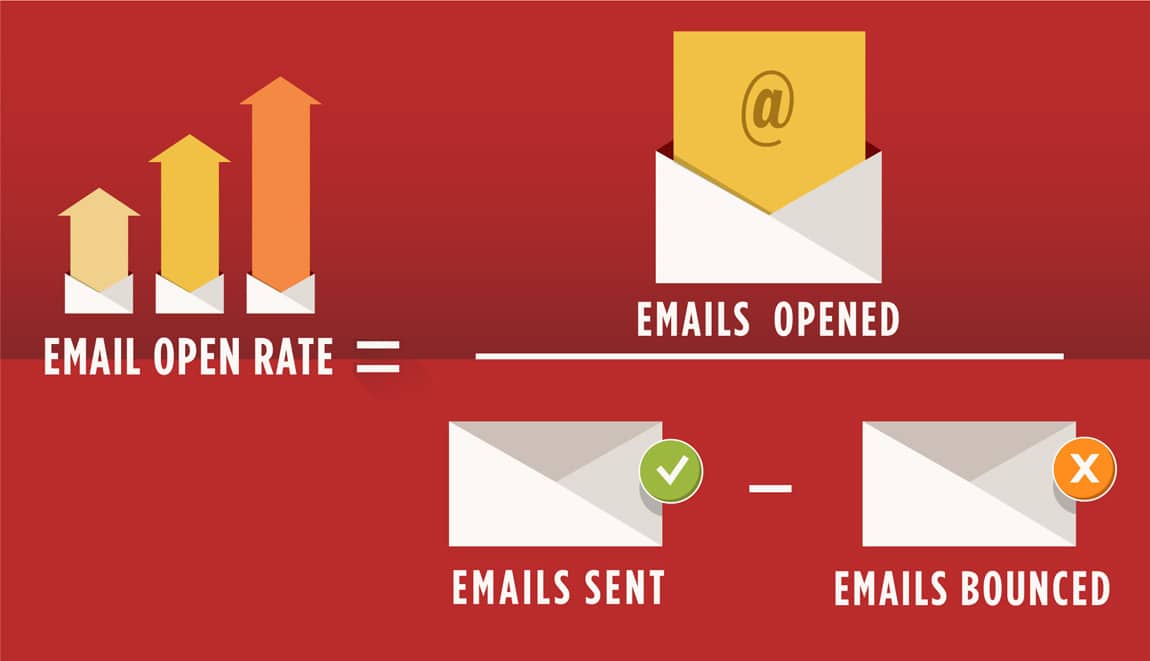
Image Source: Mailbakery
Say, for example, you sent 500 emails, 250 were opened, and 75 bounced. You would calculate: 250 / 500-75. Your email open rate would be 47%.
Most email marketing platforms have built-in tools and reports you can access to see open rates by campaign or other factor (for example, customer segment or email list). You can also look for open rates by email when you want quick insight into how your most recent send is doing.
While average email open rates vary a bit by industry, they land right around 20% overall. Campaign Monitor analyzed 30 billion emails sent across 4.2 million campaigns and determined that the average open rate across all industries is 21.5%. The report breaks down the rates across specific industries:
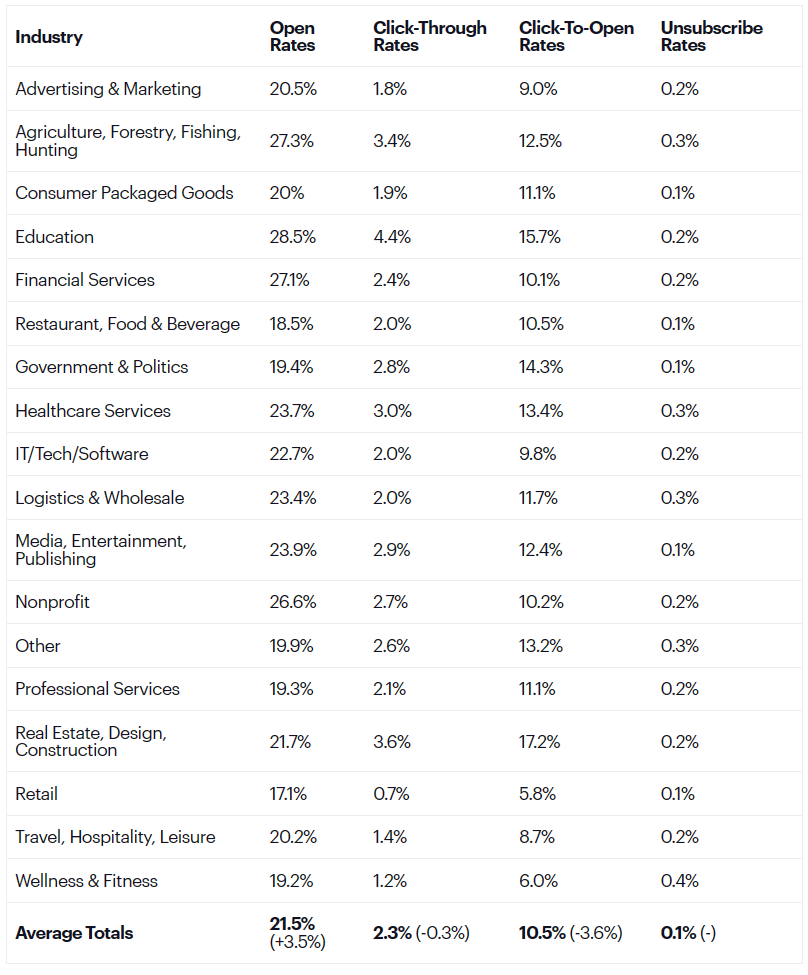
Retail had the lowest average open rate at 17.1%. This could be because retailers usually send a very high number of emails with deals and offers.
Email open rates can vary based on many different factors but there are things you can do to increase them.
1. Write Killer Subject Lines
Having an email with great content is one thing, but you need to make sure people actually open it. This is where a strong subject line comes in.
Your subject line is perhaps the most important factor of all in whether or not someone opens your emails.It should be specific, short, and enticing. What can the receiver expect if they open the email? Do you have exciting news? A new promotion? An upcoming event? This is where you want your creative juices flowing.
More than one-third of email recipients decide whether or not to open an email based on the subject line alone!
So how do you write subject lines that never fail? Here are a few quick, easy tips:
- Personalize subject lines (more on that later)
- Put value in your subject lines. Tell recipients how they’ll benefit from opening your email.
- Be concise but engaging. The best-performing subject lines stick to between 6 and 10 words.
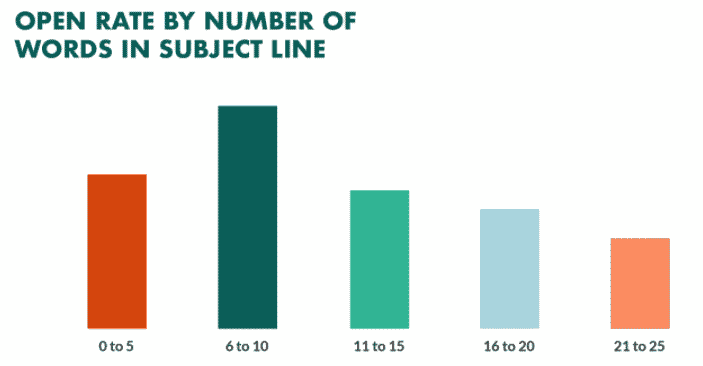
For example, a simple and direct subject line we used for one of our campaigns was – “Will You Stay With Us In 2019?”
This felt personal, and it was timely. For a group of people who had 0% engagement for months, we actually did get engagement with this email. We also followed up a week later to those who hadn’t engaged with the first email with a “Let’s Start Afresh” reminder.
2. Ensure Preheaders and Previews Look Great
First, it’s important to have a preheader. The preheader is almost like a second subject line. It can add more context to the message and is seen when the email hits an Inbox. When you are testing, see how it looks on mobile and desktop. Do the same with previews.
3. Use a Real Person as the Sender
Think about how more likely you’d be to open an email that was from Anne at XYZ Company versus [email protected] or [email protected]. Probably much more likely, right?
Sending from a personal email address also helps determine where your email will land in an inbox. If sent from a “list” name, the email is likely to not be delivered to a primary inbox. Outlook will probably flag it and deposit in the junk folder. If you’re sending to Gmail accounts, then Google will dump your email in the Promotions tab versus the Primary one.
This tip is a quick, easy fix that doesn’t necessarily require a real person to write the emails. You may be thinking you don’t have a specific person in that role. Or you may not want to attribute to an actual person because that employee could leave one day. Yes, these are all reasonable concerns.
The best option is to select someone in a leadership role, which may be a recognizable name to those receiving the email.
4. Find the Right Frequency and Cadence
How often should you send emails? What’s the right cadence to follow? These are two important questions. There is no single right answer, but there are best practices you can follow to figure out what works best for your audience.
The key is really to test the response of your email audience and adjust until you find the sweet spot.
Here are three tips that can help:
- Be up front and honest about how often you’ll be sending emails. When people know what to expect, they’re less likely to be surprised (or worse, annoyed) by your emails.
- Segment your lists by engagement level. Your most engaged audiences might be happy to receive daily emails (and open them at a high rate). Other audiences may be happier to receive a weekly or monthly message.
- Ask your audience! You can include a simple survey that asks: “How often would you like to receive our emails?” Adjust your strategy based on responses.
5. Figure Out the Best Day of the Week to Send
The day of the week you send your email campaigns can make a lot of difference. B2B companies tend to send emails mid-week, while consumer-focused industries might send more on the weekend. There’s no magic day to send. Much of it has to do with your own data and results.
Campaign Monitor’s analysis found that different industries have different “best” days to send:
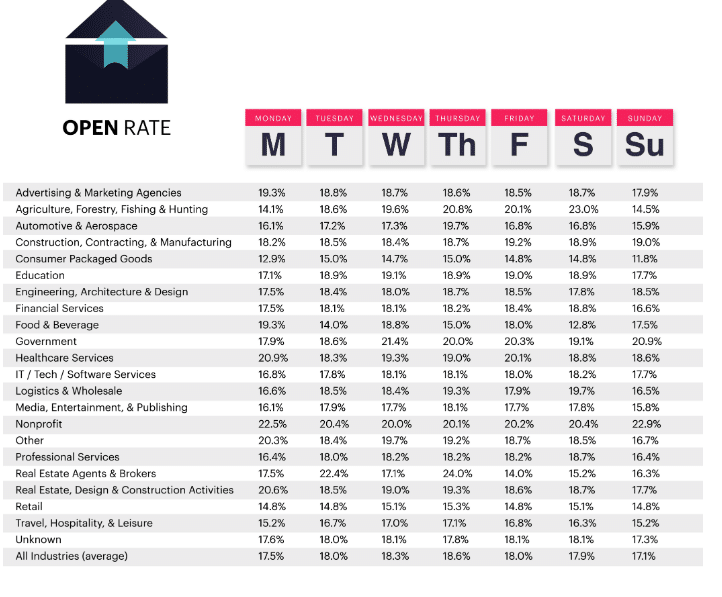
Monday is thought to be a down day for most marketers as contacts are just starting their week. However, Monday was a great day for opens for the healthcare industry, nonprofits, and real estate. Wednesday, thought to be a safe day because it’s mid-week, had some positive results, especially for government and marketing.
Looking at the weekend, which many experts have conflicting opinions about, agriculture did surprisingly well on Saturdays while construction had a nice open rate on Sunday.
Overall, the consensus was that Thursday was the best day for open rates while Sunday was the worst day.
With this data, businesses can better strategize on when to send and then compare that to their own internal data to see if it makes sense to send on Thursday versus Tuesday.
6. Optimize Sending Times
If you have regularly been sending email campaigns, you can also find the times that lead to the best open rates. If you have prospects or customers across the country or even internationally, then you are dealing with different time zones. You may find that it’s more advantageous to send in batches based on time zones.
Some email systems automate the timing of sending, however, this isn’t always effective. It’s to continue to collect data and analyze it to understand optimal times.
7. Avoid Spam Filters
Ah, the dreaded black hole of the spam filter! While it’s a good idea to check your spam filter periodically for emails you may be missing, many people never do it at all.
Most of the time, when your emails are hitting the spam folder it’s for a clear and fixable reason. First and foremost, make sure you’re following CAN-SPAM guidelines. CAN-SPAM is an act that was passed in the early 2000s to prevent people from receiving SPAM.
The image below summarizes CAN-SPAM well.
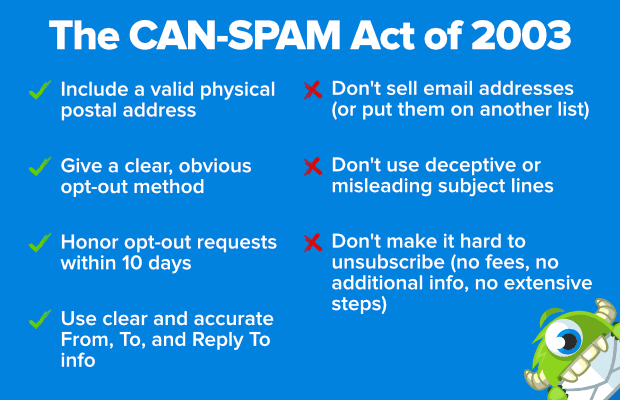
Image Source: OptinMonster
8. Ensure Your Emails Are Getting Delivered
One of the first things you can do to improve your open rate is to check deliverability rates. No one can open an email it if doesn’t hit their inbox. There are many things that can impact deliverability, including ISPs, throttling, bounces, spam issues, and bulking.
Try these tactics to improve deliverability:
- Send using custom authentication.
- Use double rather than single opt-in.
- Ensure it’s easy to unsubscribe.
- Don’t use URL shorteners.
- Refrain from sending from a free domain email address.
- Reduce the number of images in the email.
By optimizing deliverability, you can ensure that your contacts get the email. What else can you do to increase email open rates?
9. Segment Your Lists
Beyond managing your lists to keep them accurate, email segmentation for a more targeted email strategy can be a really effective way to boost open rates. People are more likely to open emails that are hyper-relevant to their interests and needs. When you segment your lists, you can deliver uniquely targeted messages that stand out to recipients.
Segmenting your email lists allows you to direct more relevant content to each group. You might segment on things like industry if you’re a B2B marketer or base it on previous purchase for B2C interactions.
You may also choose to segment based on where a buyer is in the buyer journey. For example, if your prospect is in the awareness stage, it’s important to send informational content to help them solve their problem.
The best way to segment your lists is to ask people what they want to know about when they subscribe to your email list. When you do, you can filter email addresses automatically onto the lists that make the most sense for each subscriber.
When you create emails based on these segmenting rules, your email is more likely to seem of value to the recipient, instead of just more noise.
10. Personalize Every Email
While most email recipients today can recognize automated personalization, it can still go a long way in catching their attention and getting people to think twice about opening an email. Personalization is key to any type of email marketing, no matter the industry or buyer. It can increase the likelihood of an open by 26%.
It can be as simple as a first name in the subject line or pre-header (e.g., “Michael, we think you’d really enjoy these email marketing tips…”). This snippet is all someone’s going to see before they decide to open.
Personalization can go beyond first names, too. You can personalize in some other ways, such as:
- Apply a conversational tone.
- Mention places and events local to recipients.
- Be specific about that person’s last interaction with your brand, e.g., “Glad you attended our webinar!” “Thanks for signing up for our newsletter!” and so on.
- Understand the buyer’s needs and interests. What did they click on? What’s in their wish list? What have they already bought from you? Recommend new content based on past engagement and offer deals based on past purchases.
- Create relevance and context based on time of year or season, e.g., messaging college administrators in early summer as they prepare for new students in the fall, reminding car owners of upcoming servicing dates, etc.
11. Clean Up Your Email Lists
Take time to clean up your email lists regularly. Believe it or not, email lists decay at a rate of up to 30% every year. Emails that were good for one campaign may become outdated before your next one. When you have bad emails on your list, your bounce rate goes up and your email open rate decreases.
Speaking of myself, I have multiple email lists as most businesses and companies do. Clients get different emails than those who want marketing tips. My largest list is one that goes out every morning to subscribers sharing my daily blog updates. This is the one I wanted to freshen up. Since this list is pretty large, it can be segmented out for different purposes.
For reference, before I went through and cleaned out this list, I had a solid open rate of about 10-13% which is about right on target for industry average. Not bad, but I could see that there was a number of subscribers who hadn’t engaged with any of my emails in months – neither my daily emails nor my monthly newsletters, nor any other campaign I had sent out.
Although having a large list of subscribers is great, as marketers, we know it’s really about engagement. My plan was to go in and clear out all subscribers who hadn’t engaged in 3 months or more, but before doing so, I wanted to make sure I was keeping as many people as possible. So I did this:
12. Creating a Re-Engagement Campaign
Before parting with a chunk of my subscribers, I wanted to first see if I could get them to re-engage and choose to stay on board. Again, as marketers, we all know it’s better (and easier) to retain the customers you do have than to try and win over new ones.
Since it was around the holidays and towards the end of the year, we decided the theme of the email should be seasonal. A bit of holiday cheer paired with new year goals.

We know that everyone’s inboxes get flooded in December, so it was important to offer both value – and a sense of timeliness to the campaign. As you can see above, we got straight to the point. Since this campaign was going to a low-engaging crowd, we didn’t want to waste time up front with tons of text.
Below, you’ll see we also kept the body of the email nice and tidy while adding value – my book at a discounted rate, which could be instantly downloaded. Again, since we know this is a group of subscribers with low engagement, we wanted to make sure their experience was seamless – no need to make anyone jump through hoops to get what they’re looking for.
As is always important, the copy of the email needed to stay on-brand. I really feel like my subscribers are friends and close acquaintances and I only want to add value with the content I put out, not a hassle to your inbox, so the goal was to make sure the copy reflected this sentiment. And lastly, we made the call-to-action very clear.
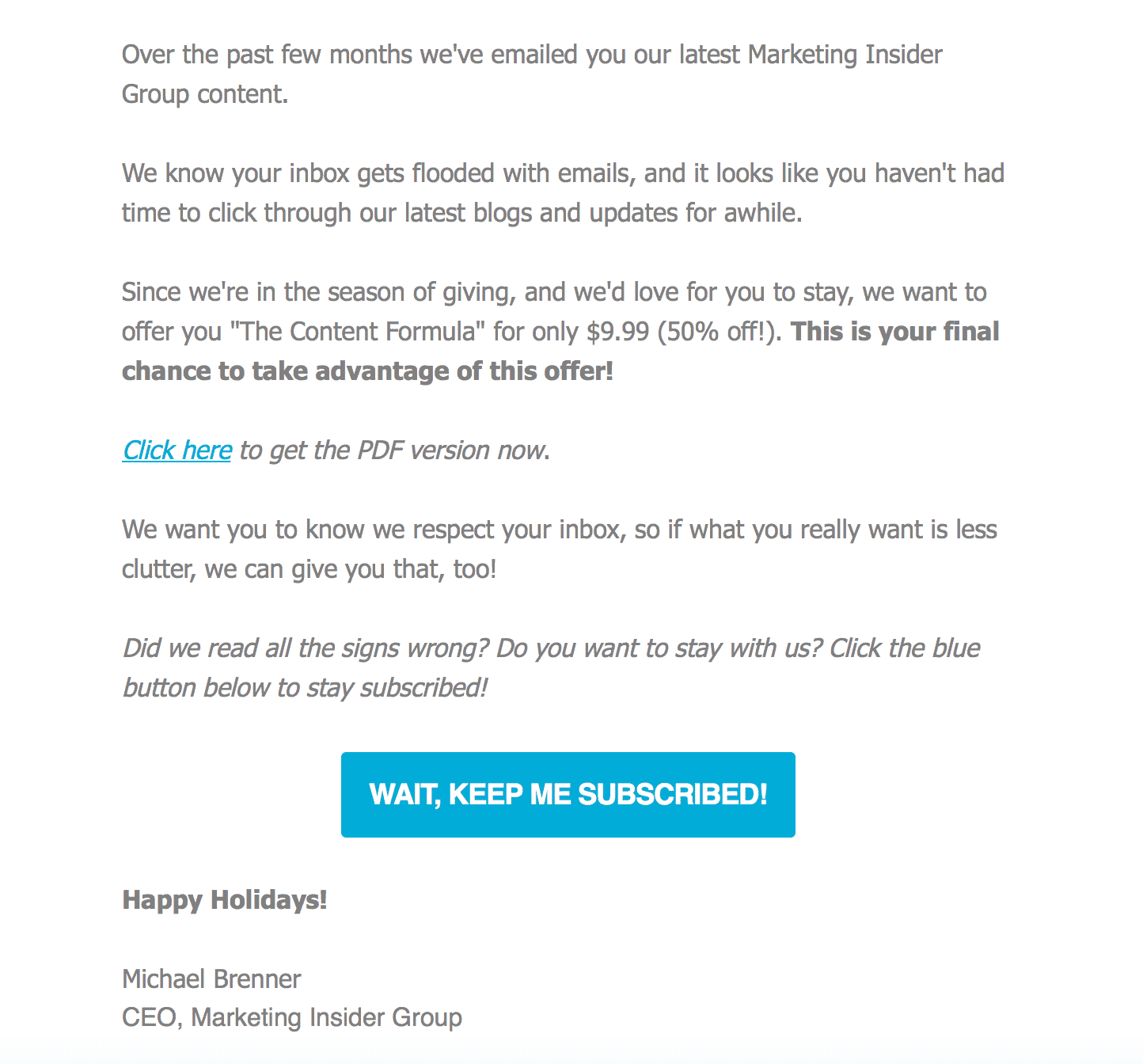
After running this campaign in December, we kept those subscribed who clicked our call-to-action button, and segmented those out who did not open it or engage.
Although once we segmented this group out our email list shrunk a bit, our open rate jumped up to 25% overnight.
3 solid months after we freshened things up, our email list continued to grow at a strong pace while our open rate was still 5%-10% higher than the previous quarter on any given day.
13. A/B Test Your Emails
A/B testing (or split testing) in email marketing is the process of experimenting with different versions of the same email to determine what earns the best results. Most email marketing platforms offer easy A/B testing features that allow you to do it automatically.
Below you can see that subject lines and CTAs are the most commonly A/B tested items, but other factors like send time, content blocks, images, and layout are also worth testing.
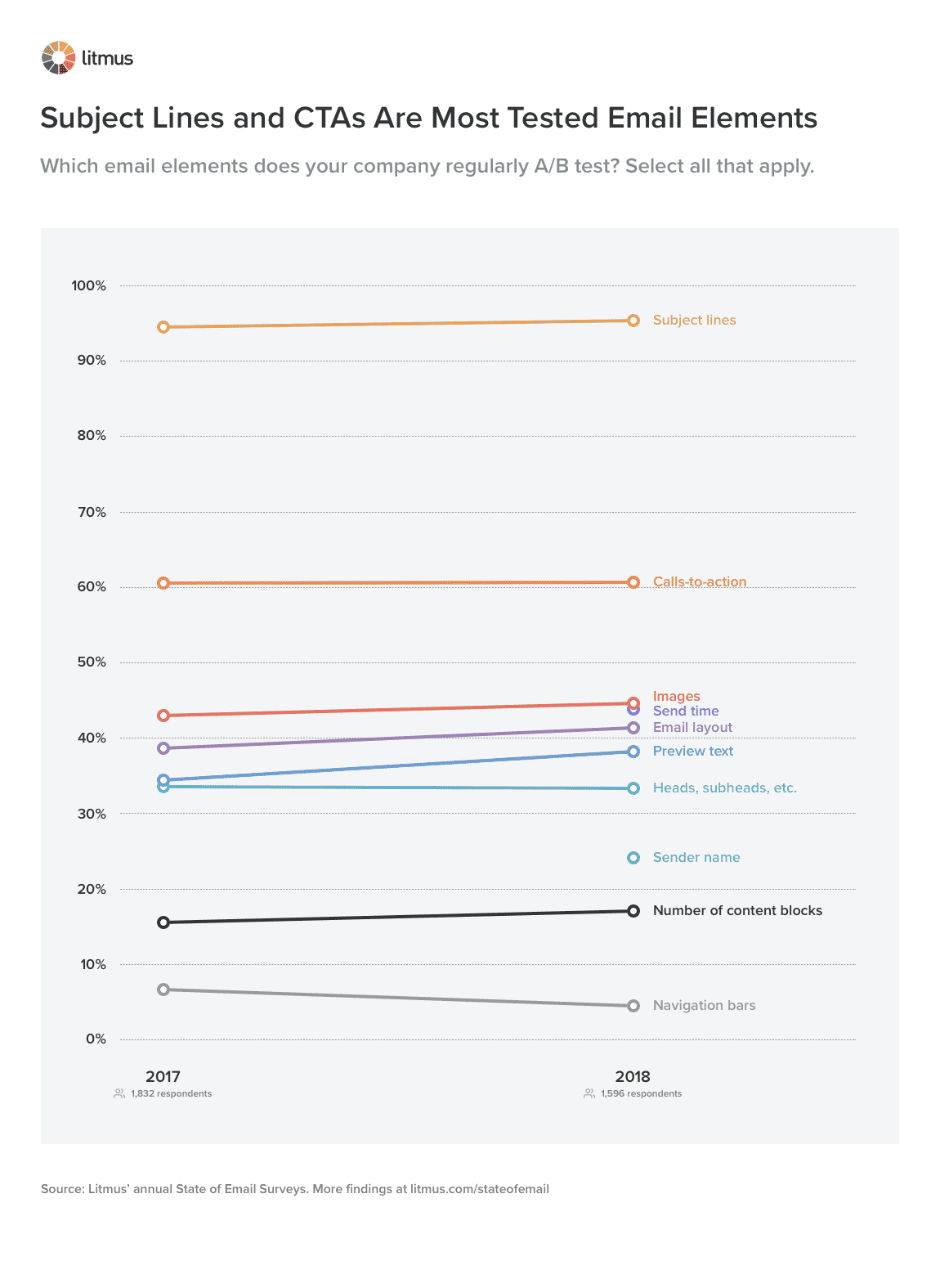
14. Ask For (and Use) Feedback
There’s no better source of information about how your emails are resonating than your audience themselves. Whether you feel like your email open rates are right where they should be or you know they need to improve, asking your audience for feedback can give you great starting points for refining and optimizing your strategy.
There are a few ways to go about it. You can send a dedicated email with a survey that asks for feedback. Another approach is to include a quick question or two at the end of every message (it could be as simple as: “Did you enjoy this email?”).
When you’re armed with direct feedback, you can identify specific things that are working (like certain topics or subject line styles).
15. Fill Your Emails with Awesome Content
There’s no doubt about it: great content is the best way to create a truly engaged audience over time — an audience that opens your emails!
Email is a great channel for sharing your blog content and other important content you want your audiences to see (and a great opportunity to nurture leads). When you consistently create customer-focused content that delivers real value and helps your audience solve their problems, you can be confident people will pay more attention to your emails when they arrive in their inboxes.
Email marketing and content creation are two of the most time consuming priorities for digital marketers today — but they’re also the most important. The team of writers and SEO experts at Marketing Insider Group can deliver you optimized, ready-to-publish content every week for a year (or more) so that you can focus on connecting directly with your audience.
Check out our SEO Blog Writing Service or schedule a quick consultation with me to learn more!






